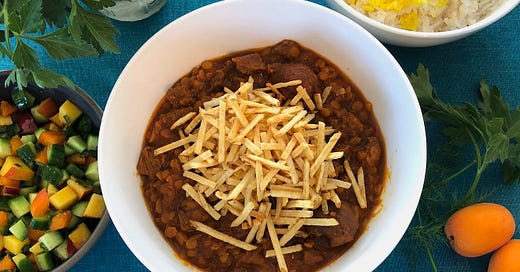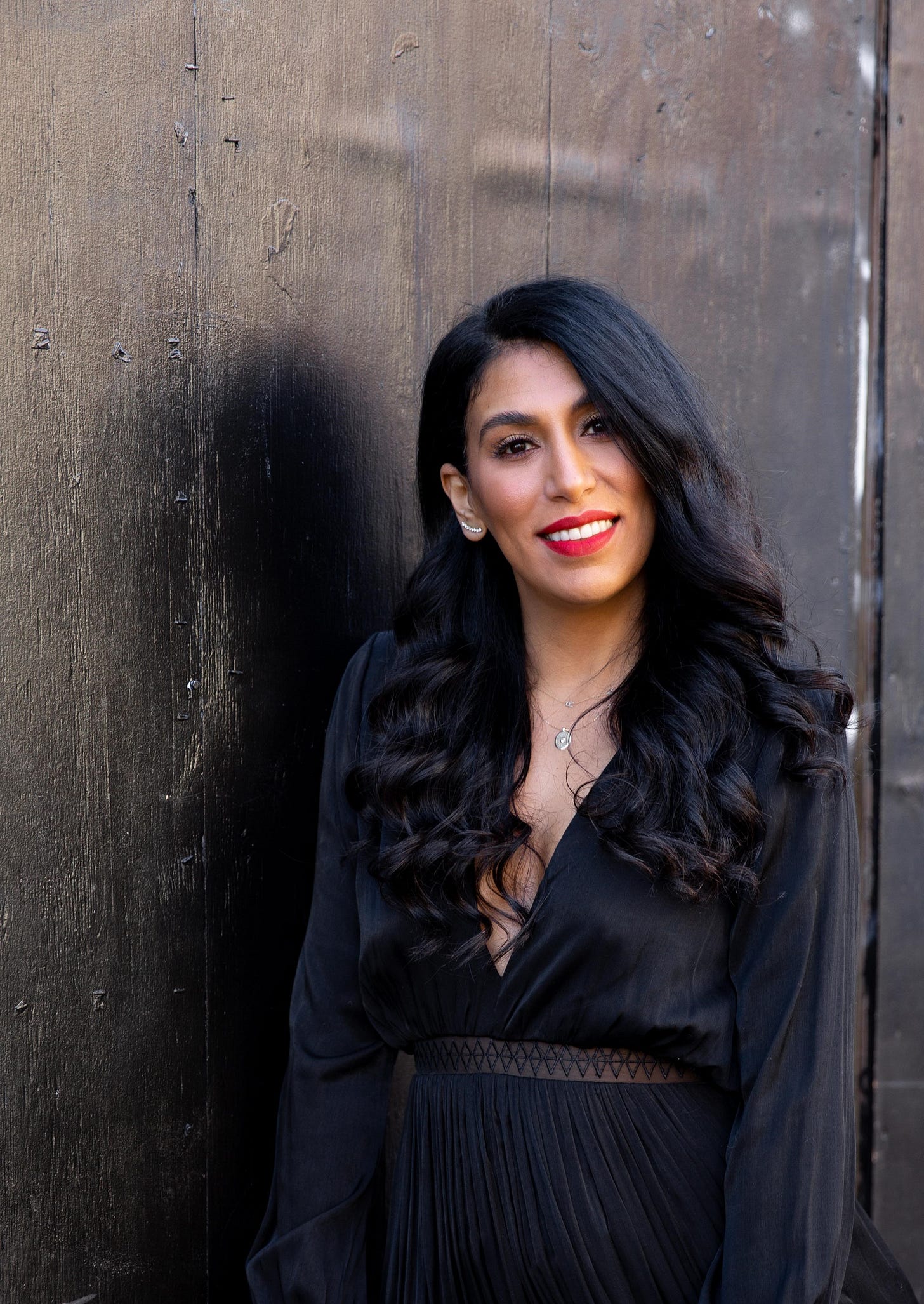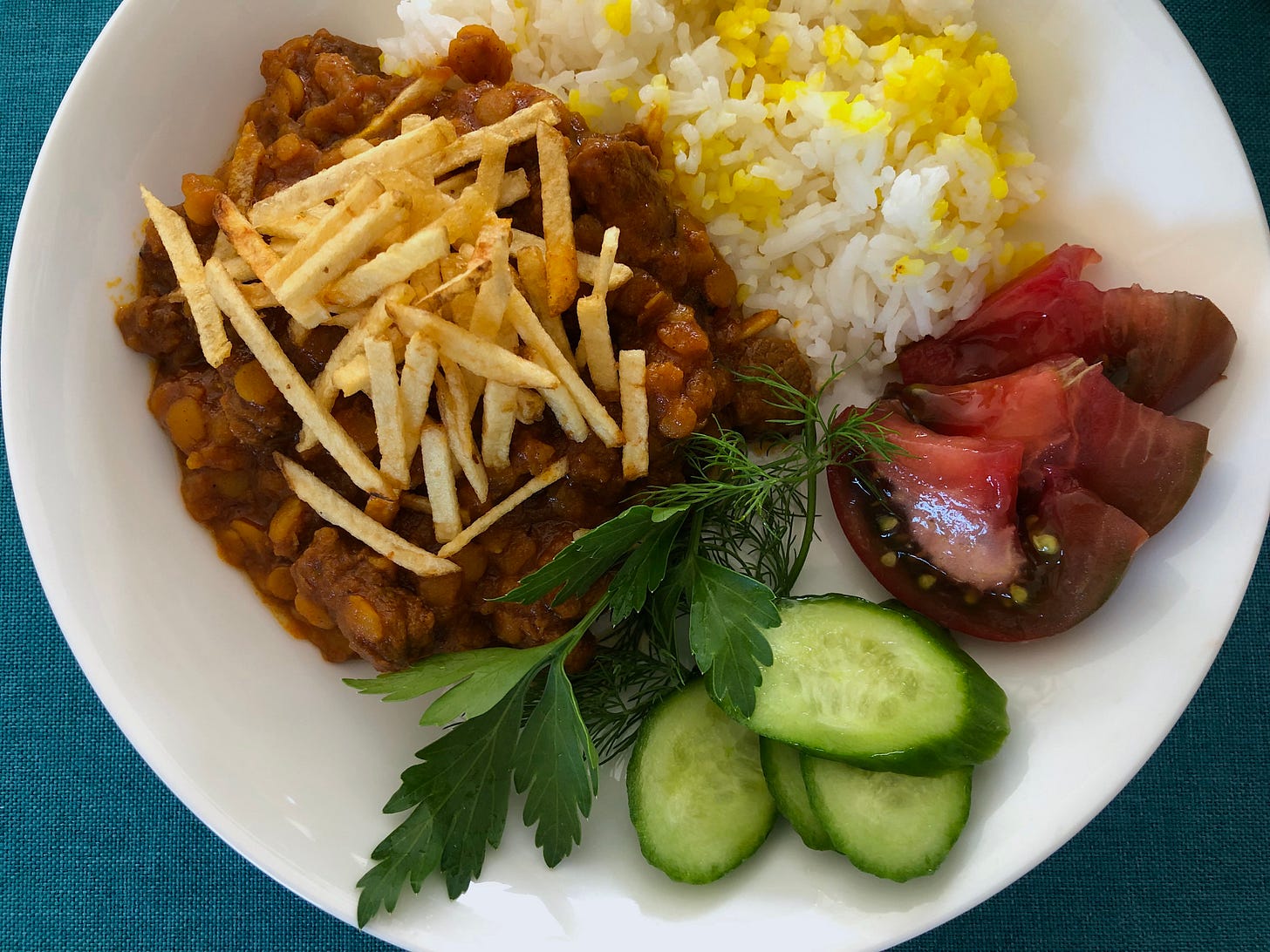When Moving to California Brings You Closer to the Flavors of Home
An Interview with Mory Fontanez of Santa Barbara
Happy Summer! And welcome new subscribers! I’m so thrilled to see so many new names here. Since there’s a bunch of you, I’ll do a quick recap of what we do here: I’m a food writer, cookbook author, and book/magazine editor, and this newsletter is devoted to looking at what California home cooking looks like in all its glorious forms. I interview home cooks from all backgrounds and share their stories in their own words, along with recipes that show their cooking styles; and I also send out stand-alone recipes from my subjects, CA-focused cookbooks, and my own kitchen. Upcoming newsletters you’ll see later this summer will include interviews with the co-founder of Oakland’s Umami Mart, a physics professor in SLO, and an olive oil producer in Northern California, along with lots of summery recipes. (Next week I’ll share my upgraded version of the classic California vegetarian sandwich that all of us suffered through in the ‘80s—hint: a little acid goes a long way.)
First, however, I have a beautiful story from Mory Fontanez, a Persian American home cook who moved to California just about a year ago. Mory is a “Purpose + Intuition coach” who works with notable leaders and public personalities and also hosts the Signal podcast. Mory and I talked about the foods her mother and grandmother have made for her all of her life and how moving to California has changed how and what she cooks. She also shared a phenomenal recipe for khoresh gheymeh—a fragrant beef and lentil stew—which you’ll find toward the bottom of the newsletter. Here’s what she told me, edited slightly for narrative flow.
Mory Fontanez
I am Persian. My parent left Tehran, Iran, right before the 1979 Islamic Revolution, because my dad was starting to get word that there was some change afoot.
They left about a year before and came to the US. They actually went to New Mexico, because my father got a student visa at the university in Portales to get his MBA. They were living in New Mexico with my sister, who's nine years older than me, and then, surprise, my mom was pregnant. So, I was born in New Mexico, of all places.
Being here when the revolution happened meant that there was a massive divide between my mom and her family, who she was very, very close to. Then the hostage crisis occurred, and the US Embassy was taken over in Iran, so US-Iranian relations really fell apart right as I was coming into the world.
What that meant was that my mom's mom, my grandmother (and her family) wasn't going to get to meet my mom’s second child, which was really heartbreaking to her. So, she took a risk and decided she was going to take me to Iran so that I could meet everyone when I was six months old.
My father stayed behind, and my sister and I and my mom went. But when we landed in Germany, for a layover, the Iran-Iraq War broke out, and the airport in Tehran shut down. So, we got stuck in Germany for about two months, living in the attic of a Persian family who were kind enough to take us in.
Finally, when they started flying to Iran, we were able to get to Tehran, about two months later. But the war was in full swing, so instead of a visit, it turned into a yearlong thing, because we weren't able to leave the country.
So, a lot of my beginnings were in chaos, really. There was a full-out war, there were bomb drills. Not that I remember it, but I have an embodied memory of it, if that makes sense. Certain loud noises, a certain anxiety when my mom is not around—which I worked on, and learned that it had to do with the anxiety of when she'd leave the house. She became a teacher to help the family, and she'd go to school, and then you'd hear these bomb alarms, and you weren't sure if she was coming back. I think I internalized a lot of that.
Because I was born in the US, my father ended up being able to claim that they were holding another US citizen hostage. So, that's how they brought me back; because I was a US citizen, basically, I got them all out.
I came back when I was about a year and a half. At that point, my father was in Colorado, and we lived there for a while. My father went to go get his MBA, but he ended up realizing he had culinary dreams. So, while we were in Iran, he went and studied at several culinary institutes in Switzerland and in Italy. He ended up being an executive chef on the ski resort where we lived in Colorado, and then became a food and beverage director. So, he's been, you know, this really impressive chef all my life. I grew up with this really interesting dichotomy of food, where I was eating American food at a five-star restaurant where that my dad was an executive chef at in Colorado, and then my mom really was making heartier, more down to earth food from Iran at home.
My mom made mostly Persian food because, I think, my dad kind of took care of the other part, so she didn't necessarily feel inclined to cook any other kind of food. But she did learn certain things. I grew up near Denver, and there's a huge Mexican population there. My uncle's wife is Chicano, and so she learned a lot of Mexican food from her, and she'd make that, too. But, you know, the Persian food was really her connection to her culture. She did everything she could to be connected to it. She wouldn't speak English to me and she wouldn't let me speak English at home for a little while, the music was always Persian music, we watched Persian movies—she was really homesick, but she was also wanting to make sure that her children were Persian.
It was a lot of work and it took a lot of discipline. Now that I have two of my own kids who barely speak Farsi, I marvel at what she did—she really had to work on ignoring me when I was speaking English, to force me to speak Farsi. And because you want to assimilate, and you want to fit in, you reject it. So, even still, by the time I was ten, I barely understood it because I was trying so hard to be American.

Now I speak it fluently because of my grandmother.
My parents got divorced when I was eight. My mom's distant family cousins were living in Maryland, so, we went out to the East Coast. During this time, there were no Iran-US relations, so my mom ended up not seeing her mom or her family for nine years. Finally, when I was about nine and a half, or ten, my grandmother was able to get a visa. And that's my first memory of my grandmother. I was a fully American child who barely spoke any Farsi, and now has this old Persian woman was in our house. She was super kind, with a loving smile, but we barely understood each other. And it caused a lot of disconnect.
I think the way that I really connected to my grandmother was, one through her spirituality—I'm an intuition coach now, so there was really a gift in me that she had seen and connected to—and two, through her cooking. That's how she communicated to me. She would make things like khoresh gheymeh, a beef and yellow split pea stew that you serve over rice. My memory of watching her make that, and it really being one of my favorites, really is burned into my brain. Just the way the house would smell; you would smell the turmeric and the tomato paste, and you knew that she was making it.
My mom also always cooked Persian food, but everything always tastes better when your grandmother makes it.
My grandmother came, and she really took care of us. My mom was a single mom at that time and struggling to make ends meet, and my grandmother was like this ray of sunshine that always had the kitchen smelling good and feeling warm and loving. So, there's such a big part of making this dish that, the smell of it, that just makes me feel safe again because of her presence and the way she would use her cooking to love on us.
My mom is such a nurturing mom that when I ended up then getting divorced from my children's father—and so I ended up being a single mom with two kids—my mom would come over with food all the time. Then when I got remarried, I married an American man, and he loved her cooking. And a Persian mom wants to take care of her son-in-law, so she'd show up with food. I cooked at home a lot in Maryland, but I didn't make as much Persian food because I didn't have to.
My husband is from California, and he has two boys in the Bay Area; we're a blended family. He was going back and forth, and it just wasn't working for him. Also, because of the work I do, I coach public personalities and leaders, and a lot of my clients ended up being in LA and in Hollywood. I didn't want to live in LA, but I came to Santa Barbara for a work thing, and just fell in love with the land and the way it looked. And so, I said to my husband, “What do you think about Santa Barbara? It's at least, you know, driving distance from the Bay Area.”
Now that we’ve moved to California, it’s like a full circle moment, where I am really understanding my mom and what it felt like to be so distant from her home and her culture.
I started cooking Persian food for myself here, because I really missed my mom and I also missed access to that food. And kids were asking for it, because their grandmother had fed it to them their whole lives. So, I would FaceTime her to ask, “How do I do this?” And through FaceTime, she would start to show me what to do. It was like all this stuff I had taken for granted that I was watching my grandmother and my mom do that I never fully made the effort to understand. This move to California really pushed me to want to understand it. So, I've been learning and cooking Persian food, and the kids get super excited because it feels like home again.
It also got me excited about ingredients and to go look for Persian grocery stores when I'm in LA. The ingredients are so much fresher here that it's a little bit more exciting to cook, because you go to the grocery store, and the fruits and vegetables are, like, gleaming—whereas when you're from the East Coast, they feel a little dull.
And there's a huge Persian population in LA, so there are like 20, 30 grocery stores to pick from. And when you go into those grocery stores, it feels like you're in Iran. The ingredients in those grocery stores, that grow in this climate—like pomegranate, like mulberries, figs—those are the things that don't grow so easily on the East Coast and get shipped in from either the Middle East or California. But here, they're growing. I'm so excited that I get to plant a pomegranate tree in my yard, because it's something that I associate, obviously, with being Persian and also my favorite fruit and my daughter's favorite fruit. There's more access to Persian ingredients because we're on the same climate of Iran.
We also look a lot of other things. We love Mexican food, so we'll do a lot of grilled meats and pair them with tortillas and fresh guacamole and things like that. I'll make some Italian food sometimes. My dad made a lot of Italian food—pasta is my way of sneaking veggies to the kids. I make a lot of fish because that's a healthier protein that they'll eat.
We make Persian food about once a week or once every other week. Sometimes it takes a little longer, and I work full-time, so it's a little harder to do, but if you prepare, you can make it easily. It does take a little more time than putting salmon in the oven or throwing pasta in a boiling pot, but we make it pretty often. And if I'm having guests, and I'm making dinner, it's always Persian food.
Khoresh Gheymeh (Yellow Split Pea and Beef Stew )
This dish is one of the classic Persian dishes that Mory remembers her grandmother cooking for her when she was a child. While it takes a couple hours from start to finish, it’s actually quite easy to make. (Mory notes that Persian food also works really well in a slow cooker; I imagine that with a bit of trial and error, you could also make this in less than an hour by using a pressure cooker.) Mory’s recipe also simplifies the recipe prep substantially by using store-bought crispy potato strips instead of the homemade fries some recipes call for. Serve the stew with Persian rice or any well-prepared basmati rice (apologies for the somewhat mushy rice in my photos!) Once you taste this dish, you’ll want to come back to make it again and again—it’s phenomenally delicious!
Serves 4
½ cup yellow split peas, rinsed
1 large onion, diced
¼ cup plus 2 tablespoons olive oil
1 teaspoon ground turmeric
1 pound stew beef, cut into ½-inch pieces
1/4 cup tomato paste
3 limu Omani (Persian dried limes), poked through with a paring knife
1½ teaspoons salt, plus more to taste
½ teaspoon black pepper, ground
½ teaspoon cinnamon
¼ teaspoon ground saffron, dissolved in 2 tablespoons of water
Crispy Potato Straws, preferably Pik-Nik brand
Par-cook the peas: Put the split peas in a medium pot with 1½ cups of water, and bring them to a gentle boil. Partially cover the pot, turn the heat down to medium-low, and simmer the split peas for 10 minutes. Drain the peas and set them aside.
Heat the oil in a large pot or Dutch oven, and sauté the onions over medium heat for 15 minutes, until they’re translucent and lightly golden.
Add the turmeric and sauté for 2 more minutes, to toast the spice.
Add the beef, turn the heat to medium-high, and sauté the meat for 5 minutes, until it is no longer pink.
Add the tomato paste, turn the heat to medium, and sauté for 2 minutes.
Add 1½ cups of water, cover the pot, and turn the heat to low. Cook the stew for 45 minutes, stirring occasionally.Add the limu Omani, salt, pepper, cinnamon to the stew and stir. Re-cover the pot and continue to simmer the mixture for another 20 minutes.
Gently stir in the partially cooked yellow split peas, and continue to simmer the stew on low heat for 15 more minutes. (If the peas don’t cook through, and the sauce is getting thick, add a little more water, as needed.) When finished, the meat should be fully cooked and tender, most of the split peas should still hold their shape, and the liquid should have turned to a thick sauce. (Adjust the water as needed.)
Add the saffron-water and gently mix everything together. Take the stew off the heat and allow it to sit for 10 minutes, to let the sauce thicken.
Transfer the stew to a serving bowl and top it with lots of crispy potatoes.
From the Archives
If you need something fun and special to bring to summer gatherings, check out the homemade onion dip recipe that Kato Banks shared with us last year—and if you haven’t, make sure to also read his stories about growing up in an Italian-Filipino family and splitting time between LA and San Francisco as a kid.
Photos: Georgia Freedman, Courtesy Mory Fontanez (3), Georgia Freedman









